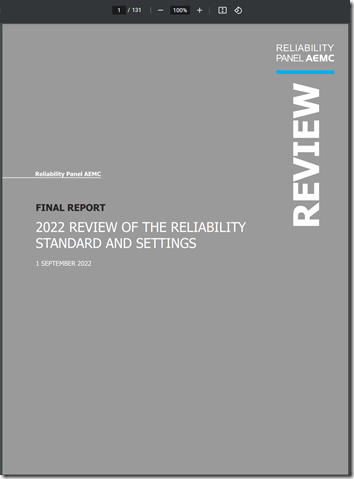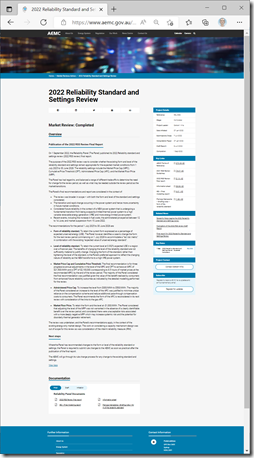Following yesterday’s release of the 2022 ESOO by AEMO (we published these initial thoughts yesterday morning) there’s been a fair amount of discussion on social media as NEM stakeholders grapple with what it all means.
However that’s not the only publication that NEM stakeholders should be aware of … I’ve been notified by several WattClarity readers today that the Reliability Panel (within the AEMC) has also published its final report into the 2022 Reliability Standard and Settings Review:
| The Report | Other Materials |
|---|---|
|
You can download the 131-page PDF of the report here:
|
On this page on the AEMC website there are a range of other materials published that are also relevant to this final report, and the process that came beforehand: . |
.
Especially given what’s been unfolding this year (particularly in Q2) with the 2022 Energy Crisis (including immediate reactions to it, like Alinta’s proposed Rule Change), this should be required reading for anyone considering how the NEM is evolving for the future.
(A) What AEMC notes about the report
On this page to accompany the release of the report, the AEMC writes:
‘The recommendations for the period 1 July 2025 to 30 June 2028 are:
1) Form of reliability standard.
To retain the current form expressed as a percentage of expected unserved energy (USE). The Panel however identifies a case to change the form for the next review period commencing on 1 July 2028 to accommodate a “tail risk metric” in combination with the existing “expected value of unserved energy standard”.
2) Level of reliability standard.
To retain the current level at 0.002% expected USE in a region over a financial year. The benefits of changing the level of the reliability standard are not sufficiently material to justify change. Changing the form of the standard, rather than tightening the level of the standard, is the Panel’s preferred approach to reflect the changing nature of reliability as the NEM transforms to a high VRE power system.
3) Market Price Cap and Cumulative Price Threshold.
The final recommendation is for three progressive annual adjustments in the level of the MPC and CPT to achieve an MPC of $21,500/MWh and a CPT of $2,193,000 (corresponding to 8.5 hours of market prices at the recommended MPC) by the end of the review period. The majority of the Panel considered the final recommendation was justified given the value of the benefit realised by consumers from enhanced future reliability outcomes as indicated by the detailed modelling performed for the review.
4) Administered Price Cap.
To increase the level from $300/MWh to $500/MWh. The majority of the Panel considered an increase to the level of the APC was justified to minimise undue reliance on the compensation scheme and reduce additional pass-through compensation costs to consumers. The Panel recommends the form of the APC is reconsidered in its next review with consideration of the links to the gas APC.
5) Market Floor Price.
To retain the form and the level at -$1,000/MWh. The Panel considered that adjusting the level of the MFP was not warranted in the absence of a clearly identifiable benefit over the review period, and considered there were unacceptable risks associated with a more deeply negative MFP which may increase systemic risk and the potential for disorderly thermal generator retirement.
—
One immediate observation is that this seems to guarantee the passage of Alinta’s proposed Rule Change.
—
More broadly, these changes also reflect what we wrote in the Executive Summary (Part 1) of GenInsights21 in that…
‘- Variability and Uncertainty are increasing
– Risks are Increasing
– Complexity is Increasing’
… which we saw resonated particularly with PV Magazine, who wrote ‘Variability compounding complexity compounding risk’ upon its release.
—
In the weeks and months ahead we’ll be considering what this means for our clients, and hence what we need to do in further enhancements to our software (ez2view and other).
(B) Early commentary about this release?
If we see other commentary about this, (as time permits) we’ll note this here:
1) Related to this update on WattClarity®:
(a) There might be comments below; and/or
(b) It may be a conversation starts up under this LinkedIn thread; and/or
(c) There might be some discussion on this Twitter thread .
2) via RenewEconomy:
(a) On 1st September Sophie Vorrath wrote about ‘Energy price caps lifted in major market shift to accommodate expensive fossil fuels’.
3) In the Australian:
(a) I note now that, on 1st September, Perry Williams wrote about ‘Increasing cap to $500MWh should cover the short run marginal cost of most generators’.
4) Elsewhere…
PS1 – The process from here
Worth noting Lynne Gallagher’s comment here on LinkedIn that…
‘I think it needs to be clear these are not the AEMC views, but the findings of the Reliability Panel. The Panel has to initiate rule changes to give effect to its recommendations.’




Leave a comment